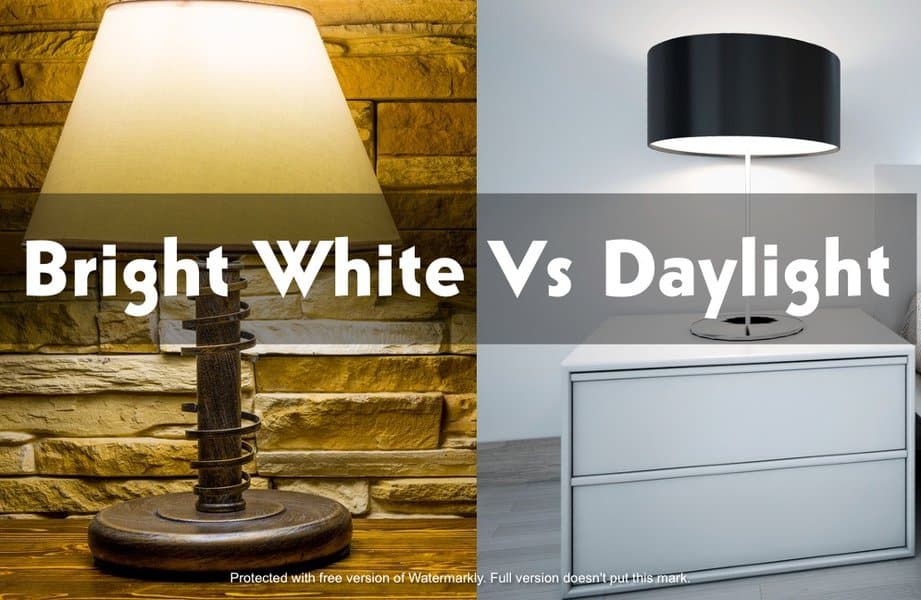Would you like to upgrade the lights in your home, but you don’t know the difference between bright white vs daylight?
Knowing the difference between the variety of light bulbs available on the market will help you with the light amount and effect you need and prefer.
Read the lines below and learn how to smartly choose light bulbs for the perfect atmosphere in your home.
What is Bright White Light?
White light bulbs can be found as “warm” white light and “cool” white light.
Warm white light has a yellowish hue, ranging between 2700 and 3500k, while cool white light has a more bluish hue, ranging between 6000 and 7000k.
If you’re looking for a more bright white light, then cool white light is what you need.
A bright white light will offer a combination of blue light and white light, the result being a more energetic kind of light.
Because of this, bright white light bulbs work best in office spaces, working areas (such as the garage), bathrooms, and even in the kitchen if it is equipped with chrome fixtures.
This kind of light may be too bright for the bedroom or living room, where a warmer white may be more appropriate.
What is Daylight?
Daylight bulbs are located at the higher end of the light spectrum, ranging between 5000 and 10,000k, and provide the brightest light.
This type of light comes with bluish hues and it is the closest to natural daylight we would normally enjoy without the help of light bulbs.
When using such light bulbs, colors will appear in higher contrast. Because of this aspect, this light is suitable for offices and working areas, for reading, and the application of makeup.
Since daylight bulbs offer bright light, just as it is during the daytime, it’s best to have these bulbs in areas of the home where you are most active.
You can probably use daylight bulbs in the kitchen, in the office or near the desk, in the living room, and next to your vanity.
Bright White Vs Daylight: What Are Their Key Differences?
01. Lumens
The lumens of a light bulb tells you just how bright that bulb can be. Of course, it matters as well where the bulb will be installed (how big the room is).
Even if the bulb is bright, it won’t matter how much if the room is too large. Always consider the size of a room when trying to determine the brightness of a bulb.
Daylight LED light bulbs ranging between 5000 and 6500k provide lumens ranging between 650 and 800.
The higher the value of the Kelvin, the more lumens the bulb will have. Bright white bulbs, on the other hand, 400 or slightly more lumens.
Another thing worth remembering is that LED bulbs require fewer watts (than incandescent bulbs) for providing more lumens.
02. Watts
When it comes to wattage it is important to mention that LED bulbs have a different wattage compared to incandescent bulbs.
LED bulbs require less wattage to produce the same amount of lumens as incandescent bulbs.
For example, an incandescent bulb of 40 watts produces about 460 lumens, while an LED bulb of only 6 watts can produce the same amount of lumens.
Have this into consideration when buying light bulbs for your home.
Speaking of bright white bulbs, they can be found with wattages between 40 and 60, if they are incandescent bulbs.
LED bright white bulbs will range between 6 to 11 watts, for the same amount of lumens.
Natural light bulbs are the brightest, so incandescent bulbs providing natural light will have wattages between 75 and 100, while LED natural light bulbs will provide the same amount of lumens for wattages ranging between 15 to 24.
03. Hue
Bright white light, even though it is called white light, has a slight yellowish hue.
Of course, it is whiter than warm white light, which has a more pregnant yellow hue, but it is yellower than natural light.
Natural light, on the other hand, goes further into the blue specter. Due to a more bluish hue, natural light appears brighter and whiter than any other type of light.
04. Temperature
Regarding light bulbs, their color temperature is measured in Kelvin degrees. The value of the Kelvin degrees lets us know if we’re dealing with warm light, cool light, or natural light.
The Kelvin scale starts at 1000k, where light is the yellowest, and goes up to 10,000k, where light is bluish-white.
Bright white light, known as “cool” white has a temperature ranging between 6000 and 7000k, while natural light has a temperature between 7500 and 10,000k.
05. Usage
To enjoy the best atmosphere in your home, it is worth making the right choices when it comes to light bulbs.
They should not only be enough (sufficient bulbs to cover the size of a room), but they should also provide the right kind of light.
Both bright white light bulbs and natural light bulbs offer bright light. Thus, they can be used in areas of the home where you’re most active or where you need good light.
Areas where you read or do your makeup, the kitchen, bathroom, and office are all good candidates for bright light bulbs.
Importance of Understanding The Difference
Is it important to know the difference between bright white light and daylight bulbs?
Yes, it is important because choosing the right kind of bulb equals getting the right kind of atmosphere and light needed to get things done effectively.
Since natural light is the brightest, you could use it in spaces where you unroll various activities.
Not only will it help you enjoy better visibility, but natural light is also energetic, promoting the right kind of state of mind when working.
Bright white light is good for working spaces as well, such as the kitchen, office, and even bathroom. It offers a combination of white and blue light, being slightly softer than natural light.
So, always think about the activities you unroll in a room and how much light might be of help there.
Choose brighter light for active areas of the home, while warmer, cozier light works best in areas where you relax or sleep.
Does Color Temperature Matter For Household Illumination?
Not all light bulbs are the same and light does matter when it comes to obtaining the right effect in our homes.
Color temperature plays the biggest role when illuminating the house. Light with an orange tint is considered as being “cozy” and “warm”, reminding us of grandma’s home.
Bright light, with a “cool” bluish tint, goes best for informal spaces, offices, reading areas and anywhere else you don’t want a cozy feeling, but a more energetic atmosphere.
Problems of Daylight
- Can be quite bright if installed in small enclosures (such as the bathroom)
- The cool light is not that comfortable for everyone
- LED daylight bulbs can be costly
Problems of White Light
- Not comfortable in the bedroom, living room, or dining area
- Space in a room must be calculated to determine how many bulbs are sufficient
How To Choose Between Bright White and Daylight
When looking to cover your needs for light at home, you have to take into consideration several aspects.
The amount of light required for each room should be based on the size of the room and the type of room or activities unrolled there during the day.
To determine how many lumens you need in each room, you can use an online calculator for lumens.
Thus, if you know the size of a room, you will find out how many lumens to use to get enough light.
Besides lumens, the other thing that should interest you is the color of the light emitted by the bulbs.
Yellow light is warmer, while bluish light is cooler, so each should be used in different rooms of the house, based on the effect you want to obtain.
Bright white light and natural light are both “cool” light options that work best in rooms with high activity.
Natural light is extremely useful if installed in an area where you read, work, create art or do makeup.
Because it is the closest option to natural light, not only will it improve your eyesight, but will also create a beautiful color contrast.
Bright white light is also bright, although it doesn’t contain as many blue hues as natural light bulbs. Thus, it is softer.
You could use it in a kitchen, especially if there are stainless steel appliances, in the bathroom and office space.
How To Create Bright White or Daylight From Conventional Bulbs?
a) Mixing Incandescent Bulbs of Different Color
There isn’t a general rule regarding how to mix incandescent bulbs to get the perfect effect and the right amount of light.
This is because the way your home is decorated can influence the way light emitted by a bulb looks.
For example, a white wall can look greenish under a bulb with a color temperature of 4000k or it can get a yellow hue under a light bulb of 2500k.
Thus, ideally, light bulbs should be picked before decorating a room (with furniture and paint on the walls).
But, since in most cases homes are already furnished and decorated, how can bulbs be picked to get the right color?
The simplest way is to decide upon a light color and pick bulbs that offer that color. Using the same kind of light bulbs all over the house will create an even feeling.
However, if you want cooler light in one room and warmer light in another, then you can use bulbs of different colors to tune the color in your home.
You’ll simply have to experiment and see which option works best for you and your home.
b) Using Phosphor Coat on Blue LED Lights
You can easily turn a blue LED light into a white light, with the help of phosphor coating.
If you have blue LED lights around and wish to enjoy white light, it is possible to use this method to convert the blue light into white light.
Why Should You Consider Buying Smart Bulbs?
A new generation of LED bulbs, called smart bulbs, is gaining a lot of popularity lately.
Connected via the house’s Wi-Fi connection and offering the possibility of being controlled with the help of an app, these bulbs can offer personalized light at any time of the day and night.
For instance, the app can even follow the sun during the day, making the bulbs provide precisely the kind of light you would normally receive.
Thus, it is possible to wake up faster in the morning, work more effectively during the day and relax in the evening, by using the same bulbs all the time.
Smart bulbs can change color and light intensity based on your preferences and without the need to change bulbs.
All you need is an app made to control the bulbs and the atmosphere within your home will be at your fingertips.
People Also Ask For
Which Light Bulb is Brighter, White Light or Daylight?
Bright white light bulbs, which range between 4000 and 5000k, offer a light combination between white and blue. Daylight bulbs, which range between 5000 and 6000k, tend to have a bluish hue.
Both types of lights are suitable for office spaces and working areas, even in the kitchen. So, it is a matter of personal preference. See which type of light appears more comfortable for your eyes.
Are Daylight Bulbs Better For The Eyes?
LED light bulbs are okay for the eyes, and much better than traditional incandescent bulbs.
Halogen lights are also good for the eyes, although these types of lights are not as durable and bright as LED lights.
Thus, most people prefer LED lights because they consume less energy, have a longer lifespan, and are much brighter.
Which Lights Are Best For a Home?
For the best ambient in your home, go for light bulbs ranging between 3000 and 6000 lumens.
This type of light can be bright enough, if it offers 5000-6000 lumens, to allow you to unroll activities in the kitchen and office, for instance.
But it can be cozy and warm enough if you choose bulbs ranging between 2500 and 3000 lumens. These bulbs can be used in the living room or dining area.
Final Words
LED bulbs are, without a doubt, a great breakthrough when it comes to indoor lighting. They are energy-effective while managing to provide the light we need.
Light bulbs capable of offering natural light can change our lives for the better. Also, bright white light allows us to work better, regardless of the natural conditions surrounding us.
You just need to take into account your preferences when choosing light bulbs.

Hello! My name is John Smith. I’m the creator of this website. Since childhood, I had a passion for cars and its mechanisms. So, I started working in the automotive industry when I just left school, and how I have over 10 years of experience in this industry. To make my experience alive through the content I started blogging through Lighting Sparkle. I hope that my experience through the content can help you a lot in making decisions and learning.

